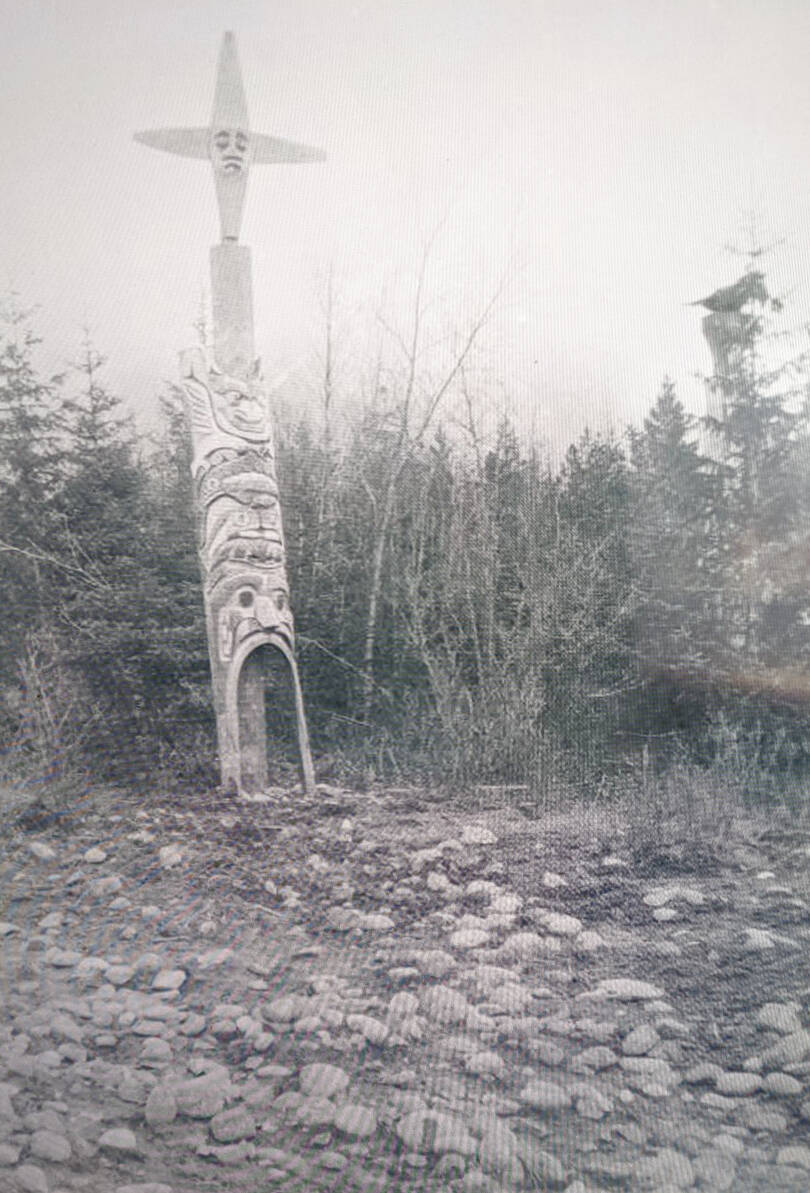Sage Birchwater
Special to Black Press Media
Restitution and repatriation of a long-lost totem pole will take place Feb. 13 in Victoria. That’s when the Royal BC Museum (RBCM) will return the Snuxyaltwa (Snooks-yell-twa) totem to the Nuxalk Nation of Bella Coola.
More specifically it will be handed over to the Snuxyaltwa (Snow) family who trace their ancestral roots to the village of Talyu at the mouth of the Taleomey River in South Bentinck Arm.
It’s expected more than 100 Nuxalk community members will travel to Victoria to witness the event at the RBCM and the ceremony at the adjoining Chief Mungo Martin Longhouse.
The storied history of the totem extends back to colonial times. It was carved by Chief Louie Snuxyaltwa (Snow) in the mid-1800s as an entrance pole for his longhouse in Talyu. It was later designated as a grave marker to honour a prominent member of the Snuxyaltwa family.
Then in 1913 the totem was removed from the burial site and taken to Victoria where it became part of the RBCM collection for over 100 years.
Hereditary Chief Yulm Snuxyaltwa (Deric Snow), great grandson of Louie Snuxyaltwa, has been the driving force behind repatriating this family treasure for three decades.
“Back in the 1990s I got a little wind of it being there in the RBCM collection,” he says. “At the time I didn’t understand what my elders were talking about. Then it came back into me by spirit, in my dream, that my great grandfather wanted to come home.”
It’s important to understand the historical context that impacted the Nuxalk Nation since the totem’s creation. When Chief Louie Snuxyaltwa (Snow) carved the entrance pole in the 1850s the Nuxalk Nation was still vibrant with a population in the tens of thousands occupying numerous villages on the Central Coast, including South Bentinck, Kwatna, Kimsquit and up the Bella Coola Valley from Q’umk’uts at the mouth of the river to Stuix 80 km up river on the Atnarko.
According to Yulm, his great grandfather Louie was a powerful man. “He had four wives and had the rights to a significant territory. A chief had up to ten wives, depending how rich he was,” Yulm explains. “So my grandfather had a lot of half-siblings.”
Then came the devastating impacts of colonialism.
It began with the Cariboo gold rush of 1859 that brought thousands of outsiders to Bella Coola, eager to get to Barkerville. Then in 1862 the smallpox epidemic wiped out thousands of Nuxalk people.
Nuxalk culturalist Clyde Tallio estimates the population of Talyu was 3,000 before smallpox. By 1921 there were only 17 people left.
He says Chief Louie Snuxyaltwa was a head carpenter and became the main carver after surviving smallpox. “He helped keep the art tradition alive through its proper use in potlatch and dance ceremonies. His teachings were so strong that they were passed down to our elders of today. He taught his sons and other young Nuxalk men of the time to carve and build houses and canoes.”
Chief Snuxyaltwa accomplished this despite the federal government’s Indian Act of 1885 that banned potlatches and other cultural expression, and the establishment of Indian residential schools.
“Even though the world was against our existence as a people he remained strong and did not conform,” Tallio says. “This is why he’s a person we look up to in Nuxalk history.”
Yulm says the Indian agent was trying to force Talyumc residents and others from other outlying communities to leave their homes and move to Q’umk’uts at Bella Coola.
“I believe my father and my grandfather were the last ones out at Talyu. They came out in the 1930s. My dad was born in 1927 and he remembers coming to Bella Coola and he didn’t know a word of English. His older sister Amanda Siwallace taught him the little bit of English she knew.”
So it was in this context, with the Nuxalk population decimated by smallpox and colonization, that the RBCM gained possession of the magnificently carved Snuxyaltwa totem.
Yulm and others say it was stolen. The RBCM says they purchased it for $45, but the Nuxalkmc weren’t in a position to argue.
The Snuxyaltwa totem became a significant feature in the museum’s First Peoples’ gallery on the third floor when the new RBCM facility opened in 1969. It remained on display until January 2022 when the museum closed the entire third floor to dismantle the First Peoples’ Gallery to “decolonize” and recreate the display with the input of Indigenous groups.
Yulm is looking forward to the totem’s return. He says the protocol is to have the RBCM hand the totem over to the Songhees and Esquimalt People, because it’s in their territory, and to have them hand it over and return it to the Nuxalk.
“Totem poles are sacred to our people. That’s why we have to go to Victoria to bring back the sacredness, the real meaning of the totem pole.”
He says the totem has an important story to tell. “I think the museums have had these things long enough. I’d like to thank them for taking care of them. If they didn’t preserve them we wouldn’t have that story. Our ancestors just want to be put to rest. We have to look after them.”
Yulm says at some point the Nuxalk Nation and Snuxyaltwa family will honour the museum and show respect for their work caring for their treasures.
Meanwhile there is more work to do; more sacred items to be repatriated and returned. “The work has just begun.”
As a measure of Louie Snuxyaltwa’s greatness, four or his great grandchildren, Noel Pootlass, James Mack, Jeff Snow, and Yulm (Deric Snow) are hereditary chiefs today.
READ MORE: Totem pole returning to Bella Coola, Nuxalk territory, after decades in Victoria museum
READ MORE: B.C. First Nation in Scotland asking museum to return totem pole taken in 1929
monica.lamb-yorski@wltribune.com
Like us on Facebook and follow us on Twitter

